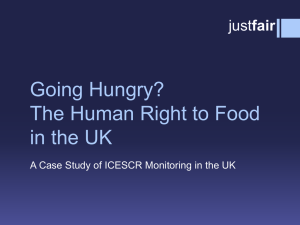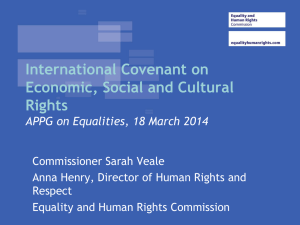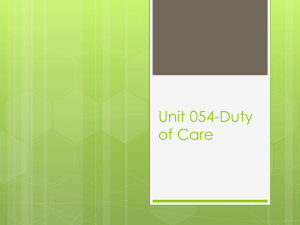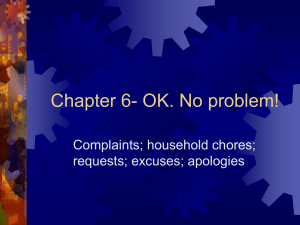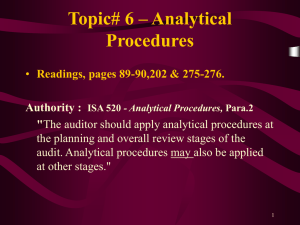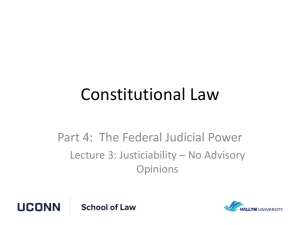Justiciability
advertisement
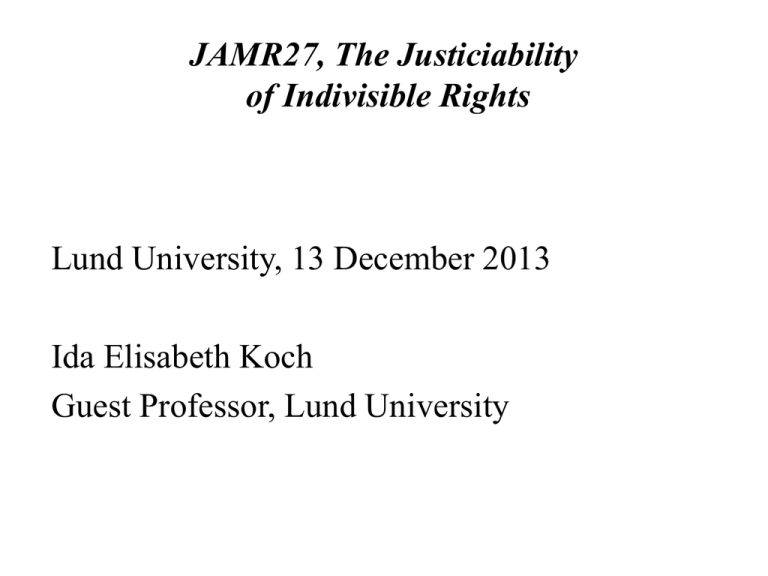
JAMR27, The Justiciability of Indivisible Rights Lund University, 13 December 2013 Ida Elisabeth Koch Guest Professor, Lund University Justiciability The notion of ’justiciability’ is commonly used in the discussion of the normative character of socio-economic rights in particular with regard to the question whether or not these rights can be enforced by judicial or quasi-judicial bodies. It does not have an unambiguous meaning and it does not appear in ordinary dictionaries over the English language. The concept of justiciability is discussed by Martic Scheinin, who identifies a variety of possible meanings; cf. Martin Scheinin, ‘Justiciability and the Indivisibility of Human Rights’ in John Squires et al. (eds), The Road to a Remedy: Current Issues in the Litigation of Economic, Social and Cultural Rights, Australian Human Rights Centre, The University of New South Wales, 2006, pp. 17-26. Cf. also Ida Elisabeth Koch, Human Rights as Indivisible Rights - The Protection of Socio-Economic Rights under the European Convention on Human Rights, Chapter 10 Justiciability 1) The role of national authorities/domestic Implementation 2) The UN’s Treaty based monitoring System 3) COE Treaty based monitoring and complaints system Remedies, the Role of National Authorities ICCPR, Article 2 (3) ICESCR: No remedies requirement ECHR, Article 13 and Article 6 (R)ESC : No remedies requirement ICESCR and (R)ESC: Why no remedies requirement? Domestic case law Three different approaches: 1) Fusa case (Norway) (minimum core rights) 2) Grootmann case (SA) (reasonableness) 3) Discrimination Norwegian Supreme Court Judgment of 25 September 1990 The Fusa case Concerning the validity of a decision limiting the amount of home care and domestic help to a severely disabled woman. The municipality had far-reaching discretionary powers However, despite the fact that the municipal budget was overstretched, the municipality had to respect a certain minimum standard Note that the Supreme Court did not define the minimum standard. The case was sent back to the municipality with the message. This is not good enough. Try again Domestic case law Three different approaches: 1) Fusa case (Norway) (minimum core rights) 2) Grootmann case (SA) (reasonableness) 3) Discrimination South African Constitution (1996) Housing 26. (1) Everyone has the right to have access to adequate housing. (2) The state must take reasonable legislative and other measures, within its available resources, to achieve the progressive realisation of this right. (3) No one may be evicted from their home, or have their home demolished, without an order of court made after considering all the relevant circumstances. No legislation may permit arbitrary evictions. Emphasis by Ida Grootboom v. South Africa (2001) The Court emphasised that neither section 26 nor section 28(1)(c) gave any of the respondents the right to claim shelter immediately. However, the programme in force in the area of the Cape Metropolitan Council at the time the application was launched fell short of the obligations imposed upon the state by section 26. Although the overall housing programme implemented by the State since 1994 had resulted in a significant number of homes being built, it failed to provide for any form of temporary relief to those in desperate need, with no roof over their heads, or living in crisis conditions. Their immediate need could be met by relief short of housing which fulfils the requisite standards of durability, habitability and stability. Emphasis by Ida Grootboom case (2001) A given measure will pass the reasonableness test if it is comprehensive and well coordinated; is capable of facilitating the right in question albeit on a progressive basis; is balanced, flexible and does not exclude a significant segment of society; and responds to the urgent needs of those in desperate circumstances. Grootboom case (2001) In the present case, it was held that, although the programme satisfied all the other requirements of the reasonableness test, it was nevertheless unreasonable in that "no provision was made for relief to the categories of people in desperate need". The state was therefore found to be in violation of section 26(2) of the Constitution. Accordingly, a declaratory order was made requiring the government to act to meet the obligations imposed on it by section 26(2), which included the obligation to devise, fund, implement and supervise measures aimed at providing relief to those in desperate need. Amartya Sen, Metarights Amartya Sen speaks of metarights. He explains that “[a] metaright to something x can be defined as the right to have policies p (x) that genuinely pursue the objective of making the right to x realisable.” The metaright e.g. to food serves the purpose of giving “a person the right to demand that policy be directed towards securing the objective of making the right to adequate means a realisable right, even if that objective cannot be immediately achieved. It is a right of a different kind: not to x but to p (x). I propose to call a right to p (x) a metaright to x”, Amartya Sen, “The right not to be hungry” in P. Alston et al. (eds.), The Right to Food, 1984, pp. 69–81 (on p. 70). Domestic case law Three different approaches: 1) Fusa case (Norway) (minimum core rights) 2) Grootmann case (SA) (reasonableness) 3) Discrimination (Brown v. Board of Education) Brown v. Board of Education (1954) Constitutional Issues The central question addressed to the Court involved the Equal Protection Clause of the 14th Amendment. Decision and Rationale For a unanimous Court (9-0), Chief Justice Warren wrote in his first and probably most significant decision, “[S]egregation [in public education] is a denial of the equal protection of the laws.” Warren declared: “To separate [some children] from others of similar age and qualifications solely because of their race generates a feeling of inferiority as to their status in the community that may affect their hearts and minds in a way unlikely ever to be undone.” The issue today is not whether judicial bodies have a say in disputes concerning resource demanding issues but where to draw the line between judicial and legislative powers when the disputed measures are resource demanding and the legal basis vaguely worded. Why are socio-ecomomic norms vaguely worded, cf. eg. Art 2(1) of ICESCR? Each State Party to the present Covenant undertakes to take steps [....] with a view to achieving progressively the full realisation of the right recognised in the present Covenant by all appropriate means including particularly the adotion of legislative measures. Division of powers. Who controls who? Legislature Executive Judiciary An extra dimension is added when the controlling body is not a domestic body but an international treaty body Interpretation of Socio-Economic Right CESCR General Comment No 3 CESCR General Comments 9 The Limburg Priciples, 1986 The Maastricht Guidelines, 1997 The Reasonableness Approach, OP to ICESCR, 2008 UN treaty based monitoring bodies ICCPR OP (ind. complaints) ICESCR CEDAW CAT CRC CRPD OP (ind. complaints) not yet in force OP (ind. complaints) OP (ind. complaints) OP (ind. complaints) The Optional Protocol to the ICESCR The reasonableness approach Optional Protocol to the ICESCR, Article 8 (2008) When examining communications under the present protocol, the Committee shall consider the reasonableness of the steps taken by the State Party in accordance with Part II of the Covenant. In doing so the Committe shall bear in mind that the State Party may adopt a range of possible policy measures for the implementation of the rights set forth in the Covenant. Emphasis by Ida COE treaty based monitoring systems The European Committee for Social Rights Reporting system Collective Complaints European Court of Human Rights Individual Complaints
